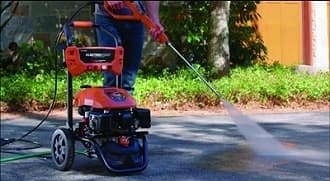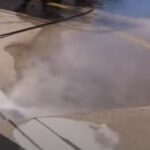As an Amazon Associate, this site earns commissions from qualifying purchases. For more information click here.
A pressure washer is a terrific tool for removing dirt, mud, mold and paint from surfaces and vehicles. We often use it outdoors, but can you use a pressure washer to clean pipes? Or will the pressure be too much and cause damage?
Pressure washers can damage pipes because the force is too strong. However you can attach a sewer jet hose to a pressure washer so you can unclog the pipes without causing damage.
Why High Water Pressure Damages Pipes
The pipes in most homes can handle water pressure up to 80 PSI, and anything above 100-150 PSI can wear out pipes and plumbing over time. Pressure washers generate much higher PSI levels so a direct spray will cause serious damage.
Water is meant to go through popes, but nonstop flow of highly pressurized water will shorten the lifespan of pipes. When plumbing wears down it starts a snowball effect which affects faucets, sinks, showers, basically everything connected to plumbing in your home.
Too much water pressure on pipes will cause leaks that affect plumbing fixtures. The force from a pressure washer will overwhelm the internal air chambers in water fixtures. When there is high pressure, it generates a water hammer effect that can damage water fixtures.
Broken or leaking pipes – and fixtures – cost a lot of money to repair. You also have to pay more to the utility company since water is leaking. Bottom line is that high water pressure is not good for pipes and plumbing.
How a Sewer Jetter Prevents Pressure Washers from Damaging Pipes
You cannot and should not use a pressure washer as is to clean pipes. But if you connect a sewer jet hose or sewer jetter, you can unclog pipes without inflicting any damage.
A sewer jet hose has a nozzle at one end. It is long, flexible and can handle high pressure. It usually has three rear-firing jets and one front-firing. The rear jets propel the hose forward while cleaning the sides, and the front removes any pipe blockage in its way.
if you are looking for one, we suggest the Zofine Sewer Jetter Kit. It comes with a 100 ft hose and a coupler, plug and nozzles It is also compatible with many pressure washers.
Once a sewer jet is connected to a pressure washer, you can use it to unclog all kinds of plumbing including drains as well. It is more effective than a snake drain because it has multiple jets.

What type of pressure washer to use? If you need to unclog pipes indoors, use an electric pressure washer. If the drainpipe is outside you can use a gas pressure washer. Never use gas pressure washer indoors to avoid inhaling fumes or accidentally starting a fire.
Electric pressure washers are not as powerful as gas, so they only work on 4 inch diameter pipes or smaller. Gas pressure washers can handle larger pipes.
How to Connect a Sewer Jetter to a Pressure Washer
You need a sewer jetter conversion kit for your pressure washer. Second, your pressure washer must be capable of at least 1500 PSI and no more than 4000 PSI. The Simpson Cleaning MSH3125 MegaShot for instance, will work here. The sewer jetter should be 2000 PSI minimum and 2 GPM.
Your sewer jetter conversion kit includes the hose, several nozzles and the coupler plug. The hose is usually 40-100 ft. which is enough for most homes. The nozzles have specific functions, such as general pipe cleaning, unclogging and getting rid of debris.
This video shows you how to connect a sewer jet hose to a pressure washer. Before you try this, make sure you are using the right kind of gas to get the best results. If you prefer to read the instructions, follow these steps.
Here are the steps.
Step 1
Connect your pressure washer to the water line.
Step 2
Attach the sewer jetter connect coupler to the pressure washer wand.
Step 3
Attach the sewer jetter nozzle of your choice to the other end.
Now that the sewer jetter is connected to the pressure washer, you can start using it.
How to Use a Pressure Washer to Unclog Pipes
This video shows you how to unclog pipes with a pressure washer. Make sure you plug a sewer jet hose to the end of your pressure washer before attempting this.
Step 1
Turn your pressure washer on.
Step 2
Insert the sewer jet hose 12 inches into the drain.
Step 3
Press the spray wand handle and bring the hose further down. After going down 3-5 feet or so, pull it up again and then let the hose go down further. Repeat until you reach the bottom or the clogging has disappeared.
Step 4
Pull the hose up if you hear the water pressure so it can clear up.
Step 5
Pull the sewer jet hose up until only 12 inches remain in the drain. Let go of the wand handle. Pull out the entire hose when the water has ceased.
Step 6
Unplug the water hose. Use the white nozzle on your pressure washer to clean it up.
Signs of Clogged Pipes
Because too much pressure is bad for pipes, you have to know the signs of clogging. The following are the most common symptoms of blocked drains and pipes.
Sewer water comes up. This is the most conspicuous and worst sign: sewage water comes out of the sewer clean out spout and makes a huge, smelly mess. This usually happens when the pipes are clogged.
- Sewer water comes up. This is the most conspicuous and worst sign: sewage water comes out of the sewer clean out spout and makes a huge, smelly mess. This usually happens when the pipes are clogged.
- Fluctuating toilet water level. This is something we do not usually pay attention to. But clogged pipes will alter the water level in the toilet. This only happens if there is a blockage so it is a reliable indicator.
- Noises in the sink. If you hear gurgling-like sounds when water drains, it means there is clogging. Even if the drain is still working, it is only a matter of time before it gets blocked completely.
- Slow draining. This is an obvious indicator as well. It is taking a long time to drain because there is something blocking the pipes.
- Foul odor. If there is a foul smell coming from the sink, something organic is clogging it up.
If you notice any of these, you should clean the pipes right away. If you prefer to do things yourself, getting a sewer jet conversion kit is a good idea. Follow the steps given above and you should be able to fix those clogged pipes quickly.
Frequently Asked Questions
Can I use a pressure washer to unclog a pipe?
You can use a pressure washer, but you have to attach a sewer jet hose to it. A sewer jet hose reduces the pressure but is still able to unclog pipes. There are many sewer jet conversion kits available. Check with the manufacturer if your pressure washer can be used with a sewer jet hose.
What is the difference between a hydro jetter and a sewer jetter?
They are the same.
Can a sewer jetter damage pipes?
Regularly maintained pipes should be fine. However, old clogged pipes that are never or rarely maintained may suffer damage. Old pipes probably have structural defects already and a high pressure wash can make it worse.
Which is more effective, snaking or sewer jetter?
A sewer jetter is more effective in getting rid of large blockages.
Can a pressure washer unclog a pipe without a sewer jetter?
It can, but the pressure would be too much for the pipes. A pressure washer can unclog the pipe, but the force would damage the structure too.
How much pressure can a pipe handle?
Most pipes can handle up to 80 PSI. If it is higher that will put the pipe under stain. That is why you need a sewer jetter for your pressure washer.
Should I use an electric or gas pressure washer?
Gas pressure washers can only be used outdoors. For indoor pipe unclogging, use an electrical pressure washer.
Can a pressure washer equipped with a sewer jetter unclog pipes covered by tree roots?
If the roots are small enough yes, otherwise you should consult a professional to remedy the situation.

I love the outdoors and all the tools for maintaining gardens, yards and lawns. The only thing I am more passionate about is sharing what I know about garden and outdoor equipment.


